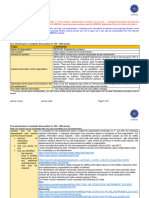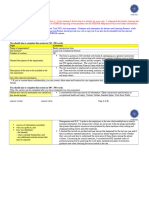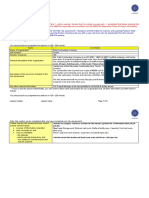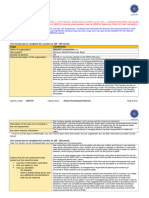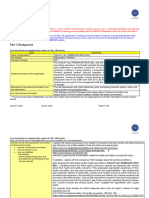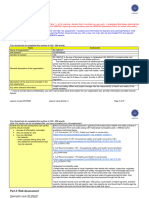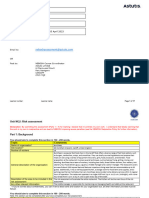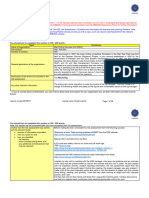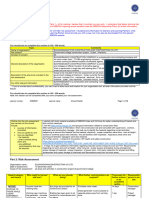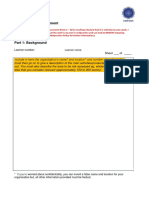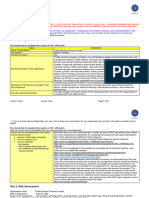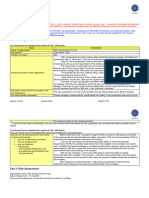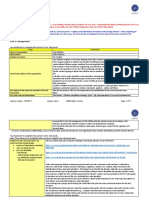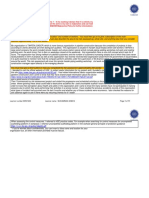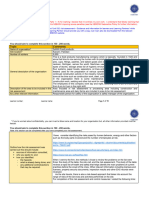Muhammad Adeel IG2 Risk Assessment Report
Muhammad Adeel IG2 Risk Assessment Report
Uploaded by
205121Copyright:
Available Formats
Muhammad Adeel IG2 Risk Assessment Report
Muhammad Adeel IG2 Risk Assessment Report
Uploaded by
205121Copyright
Available Formats
Share this document
Did you find this document useful?
Is this content inappropriate?
Copyright:
Available Formats
Muhammad Adeel IG2 Risk Assessment Report
Muhammad Adeel IG2 Risk Assessment Report
Uploaded by
205121Copyright:
Available Formats
Unit IG2: Risk assessment
Declaration: By submitting this assessment (Parts 1 – 4) for marking I declare that it is entirely my own work. I understand that falsely
claiming that the work is my own is malpractice and can lead to NEBOSH imposing severe penalties (see the NEBOSH Malpractice Policy
for further information).
Important note: You must refer to the document ‘Unit IG2: risk assessment – Guidance and information for learners and Learning
Partners’ while completing all parts of this assessment. Your Learning Partner should provide you with a copy, but it can also be
downloaded from the relevant resources section for this qualification on the NEBOSH website.
Part 1: Background
You should aim to complete this section in 150 - 200 words.
Topic Comments
Name of organisation* Continental Oil Drilling Co. Ltd
Site location* Dhurnal, Punjab, Pakistan
Number of workers 460
Continental Oil Drilling Co. is an oil and gas exploration and production company with a
focus on onshore drilling operations. The company has developed a reputation for
developing safe, efficient and reliable drilling services to clients across the country with a
long history of expertise and experience in the industry. The rigs operate on a 24/7 basis
depending on the nature of its drilling and production activities. This may include round-
General description of the organisation the-clock shifts for rig operators, as well as support staff working regular business hours.
As a large national company, its employs individuals from a range of fields including
geologists, rig operators, support staff etc.
The company follows strict safety and environmental regulations and adjusts its
operations in response to changing weather conditions, regulatory requirements and
other factors.
Learner number: 00757282 Learner name: Muhammad Adeel Page 1 of 41
The risk assessment will cover mud tanks, pump house, tool house and generator house.
Mud tanks: These are large storage tanks used to hold drilling mud, a mixture of water,
clay, and other additives that is used to lubricate and cool the drill during drilling
Description of the area to be included in operations.
the risk assessment Pump house: This building houses the pumps that circulate the drilling mud between the
mud tanks and the drilling rig.
Tool house: This is a storage area for drilling tools and equipment.
Generator house: This building houses the generators that provide power for the rig.
Any other relevant information N/A
* If you’re worried about confidentiality, you can invent a false name and location for your organisation but, all other information
provided must be factual.
You should aim to complete this section in 100 - 200 words.
Note: this section can be completed after you have competed your risk assessment.
Outline how the risk assessment was To conduct a construction risk assessment, we referred to the Safety and Health in
carried out this should include: Construction Convention, 1988 and ILO Recommendation R175 - Safety and Health in
• sources of information consulted; Construction, 1988 for best practices. A visual inspection of work activities was conducted,
• who you spoke to; and and the company's occupational health and safety documents, audit reports, and history
• how you identified: of accidents and incidents were reviewed. Interviews were conducted with workers to
- the hazards; gather information on the use of PPE and the effectiveness of control measures. Relevant
- what is already being done; and sources such as the HSE website and recognized codes of practice were also consulted.
- any additional controls/actions The accident book and sickness absence records were reviewed for recurring issues
that may be required. related to illness or incidents. The objective of the assessment was to identify hazards and
their controls, assess the adequacy and effectiveness of current controls, and determine if
additional measures were needed. This approach included a combination of visual
inspections, interviews with workers, and referrals to relevant sources to ensure a
comprehensive risk assessment.
http://ilo.org
Learner number: 00757282 Learner name: Muhammad Adeel Page 2 of 41
https://www.osha.gov/
https://www.hse.gov.uk/msd/manual-handling/index.htm
https://www.hse.gov.uk/toolbox/height.htm
https://www.hse.gov.uk/chemical-classification/index.htm
https://www.hse.gov.uk/chemicals/using.htm
https://www.ilo.org/global/topics/safety-and-health-at-work/lang--en/index.htm
https://www.ccohs.ca/topics/hazards/workplace/
https://www.ccohs.ca/topics/wellness/mentalhealth/
https://www.ccohs.ca/topics/hazards/ergonomic/
Learner number: 00757282 Learner name: Muhammad Adeel Page 3 of 41
Hazard category and Who might be What are you already What further Timescales for Responsible
hazard harmed and how? doing? controls/actions are further actions person’s job
required? to be completed title
(within …)
Fire and Explosions • Workers at the • Assembly point has • Install CCTV cameras 1. One Store manager
• Leaks and spills: If a drilling site, been designated for ongoing Month (action 7)
flammable liquid including drill • Fire Emergency surveillance 2. One Finance
leaks or spills, it could operators, procedure is in place • If possible, Install month manager
quickly catch fire and engineers, • Manual fire alert automatic/intelligent 3. One (action
spread, posing a fire technicians, system is in place fire detecting and Month 2,3,4,5,6,7
risk. To stop spills and and support • Safety signs are alert system with 4. One Week ,8,9,10)
leaks, proper staff. These displayed flame, heat and 5. One Week Safety
handling and storage workers may be smoke detectors 6. One Supervisor
techniques are exposed to • Hire a fire spotter Month (actions
essential. flammable • Set up policy for the 7. One Day 12,13)
• Sources of ignition: materials, regular maintenance 8. One
Flammable liquids hazardous of fire extinguishers Month
can catch fire or chemicals, and • Conduct random 9. Two
explode when high sampling test on the Month
electrical equipment, temperatures, fire extinguisher 10. One Week
open flames, or which can • See to the possibility
sparks are used to increase the of Arranging Fire
ignite them. risk of fire and training and mock
Controlling potential explosion. exercise
ignition sources is • Local residents • Ensure the safety of
crucial, as is making who live near keys to prevent
sure that all the drilling site. unauthorized entry
equipment is Fires and to the storage
grounded and well- explosions can compound
maintained. cause property • Provide Day time
• Storage tanks: Leaks damage, and night security to
and fires must be injuries, and the storage
avoided when fatalities to compound
Learner number: 00757282 Learner name: Muhammad Adeel Page 4 of 41
designing and people living in • Hire patrolling
maintaining storage the vicinity of guards
tanks that contain the drilling site. • Show Zero-tolerance
combustible policy for the onsite
substances. To reduce smoking
the chance of a fire or • Strictly ban smoking
explosion, tanks inside the storage
should also have compound
enough ventilation • Provide a smoking
and fire suppression room for the smoker
equipment. where they could
smoke
Weather Weather conditions • Monitoring weather 1. Design of the • Six Contractor/Rig
• Lightning strikes: If that result in accidents conditions: building: The design months Manager
safety precautions are or equipment damage • Evacuating workers of a rig's building • Every (action 1)
not taken, lightning could endanger the • Securing equipment can help mitigate Week Safety
strikes can seriously safety of the rig's • Providing protective the effects of severe • Two inspector
endanger people and workers. For instance, clothing or gear weather. For months (action 2, 4)
property. strong winds can • Implementing example, buildings • One Finance
• High winds: High make things fall, while emergency response can be designed month manager
winds can harm the lightning strikes can plans with wind-resistant • One (action 3)
oil rig's buildings and start flames or • Conducting regular features to prevent month Rig manager
equipment and put produce explosions. safety drills damage from high (action 5)
people who are • Workers may winds.
working at heights in also be 2. Regular inspections:
danger of falling. exposed to Regular inspections
hazardous of the rig and its
chemicals or equipment can help
Learner number: 00757282 Learner name: Muhammad Adeel Page 5 of 41
substances identify potential
when weather hazards and ensure
conditions that everything is in
cause leaks or proper working
spills. For order.
example, heavy 3. Communication
rains or systems: Oil rig
flooding may operators should
increase the have reliable
risk of spills communication
that can systems in place to
contaminate communicate with
nearby water workers and
sources or emergency
cause responders in the
respiratory event of severe
problems for weather.
workers. 4. Training and
education: Workers
should be trained
and educated about
the risks associated
with severe weather
and the proper
procedures for
managing those
risks.
Learner number: 00757282 Learner name: Muhammad Adeel Page 6 of 41
• Joint planning: oil
rig operators should
work closely with
local emergency
services and
authorities to
develop and
implement
contingency plans
for severe weather
events.
Falls All employees and • Fall protection 1. Remove 1. One Safety
• Trips and slips: visitors to the site equipment contamination from Month Inspector
Workers may trip or • The danger of • Guardrails the floor to avoid 2. Daily (action 1, 2, 3)
slip on wet or uneven slips and falls • Non-slip surfaces any slip 3. One Finance
surfaces, leading to a resulting in • Regular inspections 2. Mop dry the wet Month Manager
fall. injuries • Job planning and floors to avoid any 4. One (action 4,6,8)
• Unsecured ladders or increases when hazard assessments slips and trips Month Rig manager
stairs: Ladders and the floor is 3. See to the possibility 5. One (action 4, 5,
stairs that are not contaminated of redesigning the Month 7,8)
properly secured or or the stairs are steps and stairs 6. Two
maintained can lead in poor where required Weeks
to falls. condition. 4. Fix guard rails to the 7. Weekly
• Unprotected edges: Minor to severe stairs to avoid falls 8. Every one
Elevated platforms injuries, such as 5. Improve the Week
and walkways that are fractured bones conditions of the inspection
not properly guarded in the wrists, site floors to reduce
arms, or hands, likelihood of falls
Learner number: 00757282 Learner name: Muhammad Adeel Page 7 of 41
can present a fall back injuries, or 6. Provide spill kits to
hazard. brain injuries, the machines
may result from 7. See to the planned
the collision. maintenance of all
the site plants and
machines to avoid
any leakage
• Engage a labour to
ensure the quick
cleansing of the
spillage or any other
contamination on
the floor
Equipment Malfunction Workers may be • Regular equipment 1. Use of advanced 1. One Rig manager
• Loss of well control: If exposed to hazardous inspections and monitoring Month for (action 1,2)
equipment chemicals or maintenance technology any Safety
malfunctions, it can substances if • Training of personnel 2. Equipment upgrades upgrades inspector
lead to a loss of equipment • Use of safety and replacements 2. One (action 1, 4, 5)
control over the well, malfunctions result in equipment. 3. Root cause analysis month
potentially leading to leaks or spills. These • Installation of safety 4. Operator training 3. One week
a blowout or other exposures can cause devices and qualifications 4. One
serious incident. respiratory problems, • Use of redundancy 5. Encouraging a Month
• Equipment failure: skin irritation, or other and backup systems culture of safety. 5. One
Equipment failure can health effects. month to
occur in a variety of • Workers may three
ways, including also be months
mechanical failures or exposed to
failure to follow hazardous
Learner number: 00757282 Learner name: Muhammad Adeel Page 8 of 41
proper procedures for chemicals or
maintenance and substances if
inspection. equipment
• Human error: Human malfunctions
error can contribute result in leaks
to equipment or spills. These
malfunctions, exposures can
particularly if workers cause
are not properly respiratory
trained or if safety problems, skin
procedures are not irritation, or
followed. other health
effects.
Chemical Exposure • Workers on the • Following proper • Regular risk • Every 15 Safety
• Inhalation hazards: oil rig: safety measures: To assessments: days inspector
Some chemicals can Depending on reduce the risk of Regular risk • One (action 1, 4, 5)
be inhaled and cause the type and chemical exposure or assessments can month to Security Officer
respiratory problems, extent of explosions, workers on assist identify implement (action 2, 3)
such as coughing or exposure, the oil rig are urged to possible risks and • One
difficulty breathing. workers who adhere to all necessary places where safety month
• Skin contact hazards: handle or come safety precautions. rules and • Every
Some chemicals can into contact When handling or procedures can be week
cause skin irritation, with hazardous transporting improved. This can • One
burns, or other types chemicals are hazardous substances, assist in ensuring month
of skin damage. at risk of this entails donning that the right safety
• Eye hazards: Some exposure, PPE, attending safety precautions are put
chemicals can cause which may training sessions, and in place to reduce
eye irritation, have short- or according to the risk of chemical
Learner number: 00757282 Learner name: Muhammad Adeel Page 9 of 41
chemical burns, or long-term established safety exposure or
even blindness health impacts. regulations. explosions.
• Residents in • Regular safety audits • Implementing a
the area: can assist identify permit-to-work
Residents in possible risks and system can assist
the area may places where safety guarantee that any
be at risk of rules and procedures work involving
health impacts need to be improved. hazardous chemicals
from exposure To provide a safe is planned and
to chemicals working environment, completed safely. To
discharged into it is crucial to carry out do this, legal
the air or water these audits frequently authorisation must
depending on and to put remedial be obtained for the
the type and measures in place as project, it must be
intensity of the necessary. confirmed that all
chemical • Chemical storage and necessary safety
exposure. labelling procedures: precautions are in
• Emergency To prevent abuse or place, and workers
responders: unintentional must be properly
During the exposure, hazardous trained and
response effort, chemicals should be equipped.
emergency stored in the right • Creating an
responders containers and emergency response
who are correctly marked. This plan: To guarantee
dispatched to includes making that the proper
the scene of a certain that chemicals actions are taken in
chemical leak are kept in the suitable the event of a
or release run chemical incident or
Learner number: 00757282 Learner name: Muhammad Adeel Page 10 of 41
the risk of spaces with enough leak, an emergency
coming into ventilation. response plan
contact with • Monitoring and should be created.
dangerous limiting chemical This entails
substances. release: To avoid spills, identifying potential
• Wildlife and the leaks, and other dangers and
environment releases, it's critical to hazards, developing
can also be keep an eye on how evacuation
harmed by chemicals are handled protocols, and
chemical and used. This entails giving emergency
exposure, disposing of responders access to
which can lead hazardous material the right tools and
to air and water appropriately as well training.
pollution that as utilising the proper • Monitoring and
can have an tools and techniques testing the quality of
effect on to stop spills and the air and water on
regional leaks. a regular basis can
ecosystems and • Workers should get assist detect
the food chain. education and training potential chemical
on the potential risks releases or spills,
associated with the enabling prompt
chemicals they handle response to control
as well as how to use the problem and
and handle them prevent harm to the
safely. This entails environment,
holding consistent workers, and local
safety training sessions people.
and ensuring that staff
Learner number: 00757282 Learner name: Muhammad Adeel Page 11 of 41
members have access • fostering a safety
to the required safety culture: It's critical to
gear and protocols. foster a safety
culture so that all
employees prioritise
safety and take
ownership of
keeping the
workplace safe.
Promoting a positive
safety culture,
fostering open
discussion about
safety issues, and
praising and
rewarding safe
behaviour are all
part of this.
Noise • Workers on the • Conducting a noise • Performing routine • One Safety officer
• Hearing loss: oil rig are at assessment: A noise noise exposure Month (action 1, 2, 3,
Exposure to high danger of assessment should be monitoring: • One week 4)
levels of noise over hearing loss, done to determine Monitoring noise • One Week Rig manager
time can cause tinnitus (ear what tasks and what levels on a regular • One (action 5)
permanent hearing ringing), and areas have noise levels basis can help month
damage. other hearing- that are too high to be detect changes in • One
related safe. This involves noise exposure and month
Learner number: 00757282 Learner name: Muhammad Adeel Page 12 of 41
• Safety hazards: Loud problems if measuring the noise enable the necessary
noise can make it they are levels on the oil rig at alterations to
difficult for workers exposed to various points and controls and
to hear important loud noise for while doing various procedures.
safety instructions or extended jobs. • Providing more
warning signals. periods of time. • Implementing advanced and
• Residents close engineering controls: efficient hearing
by: Depending Engineering controls protection, such as
on how close can help to lower active noise-
the oil rig is to noise levels at the cancelling earmuffs,
residential source. Examples may be necessary if
areas, include installing noise the offered hearing
surrounding barriers, mufflers, and protection is
residents may enclosures. Utilising ineffective in
also be noisier machines and decreasing noise
subjected to equipment might also exposure.
excessive noise aid in lowering overall • Putting in place a
levels, which noise levels. hearing
might irritate • Using the proper conservation
them, disturb personal protective programme: A
their sleep, and equipment (PPE): To thorough hearing
have other lessen their exposure conservation
negative health to loud noises, workers programme can
impacts. are given the proper assist in defending
• Wildlife: hearing protection, employees against
Wildlife, such as earplugs or the negative effects
especially earmuffs. It's crucial of noise exposure.
marine life, that employees Regular hearing
Learner number: 00757282 Learner name: Muhammad Adeel Page 13 of 41
which might be consistently and testing, instruction
sensitive to appropriately wear the and training
sound, can be PPE they've been regarding noise
negatively given. exposure and
impacted by • Implementing hearing protection,
excessive noise administrative as well as ongoing
levels. controls: monitoring and
• Environment: Implementing evaluation of the
Loud noise can administrative controls program's
cause noise can assist reduce performance, are all
pollution, which overall exposure to included in this.
can have high noise levels by • Using different
detrimental limiting the time that working techniques:
effects on the workers are exposed Different working
environment by to high noise levels, techniques, such
interfering with rotating workers remote machinery
animal across activities, and monitoring and
communication providing quiet rest control, can assist
and destroying places. limit worker
natural • Training and exposure to loud
ecosystems. instruction should be noises.
provided. Employees • Changing the work
should learn about the environment:
risks that could arise Changing the work
from being exposed to environment can
loud noises, as well as assist lower noise
how to utilise personal levels. Examples
protective equipment include moving
Learner number: 00757282 Learner name: Muhammad Adeel Page 14 of 41
(PPE) and follow safety noisy machinery to a
measures to minimise less populated area
their exposure. or putting sound-
absorbing materials
on walls and
ceilings.
Ergonomics • Workers: Due • Conducting ergonomic • Conducting a job • One week Safety officer
• Back injuries: Heavy to lengthy and evaluations: To hazard analysis can • One (action 1, 4, 5)
lifting, awkward repetitive determine the regions help you discover Month Rig
postures, and other physical and tasks where unique ergonomic • One week manager/shift
ergonomic risk exertion, employees are most risks that are related • Every manager
factors can lead to unnatural likely to suffer from to each task and week (action 2)
back injuries. postures, and musculoskeletal build controls that
• Repetitive motion insufficient rest problems, ergonomic specifically address
injuries: Performing periods, oil rig assessments should be them.
the same motion over workers are carried out. • Redesigning
and over again, such susceptible to Assessments should workstations,
as using a drill, can developing measure things like supplying
lead to repetitive musculoskeletal posture, force, ergonomic tools and
motion injuries such disorders repetition, and task equipment, and
as carpal tunnel (MSDs), duration. automating
syndrome. including back • Using engineering operations are all
• Slip and trip hazards: pain, neck controls: By reducing ways to lessen the
Poorly designed discomfort, and the physical demands physical demands of
workstations or carpal tunnel of jobs, engineering tasks.
walkways can lead to syndrome. controls can assist • By allowing workers
slip and trip hazards, • Contractors reduce ergonomic to switch between
and tourists: hazards. Examples various activities and
Learner number: 00757282 Learner name: Muhammad Adeel Page 15 of 41
which can cause a Due to their include altering the eliminating
variety of injuries. inexperience height of workstations, prolonged and
and lack of using ergonomic tools repetitive motions,
training, and equipment, and job rotation can help
contractors and providing anti-fatigue lower the risk of
visitors to the mats. acquiring
oil rig may not • Providing instruction musculoskeletal
be aware of the and training: problems.
physical Employees should be • Regular training and
demands and instructed in suitable education:
risks of the job, ergonomic procedures Employees should
which could and postures, get regular training
raise their risk including how to move and education on
of suffering an and carry large ergonomic risks and
ergonomic objects, modify controls, including
injury. workstations, and take instruction on how
• Healthcare sufficient breaks. to utilise ergonomic
professionals • The importance of rest tools and
who operate on and rehabilitation in equipment, how to
offshore oil rigs preventing maintain proper
may encounter musculoskeletal posture and form,
ergonomic risks diseases cannot be and how to identify
while carrying overstated. To prevent the symptoms of
out their jobs, extended and musculoskeletal
such as repetitive actions, problems.
uncomfortable workers should be • Encouraging
postures when encouraged to take workers to report
giving medical regular rest intervals any signs or
Learner number: 00757282 Learner name: Muhammad Adeel Page 16 of 41
care or lifting and switch between symptoms of
large objects. different jobs. musculoskeletal
• Putting in place diseases, and
administrative controls conducting a
Administrative prompt
measures can assist investigation to find
lower the risk of the reason and put
ergonomic injuries by in place the
reducing the necessary controls,
frequency and are important steps
duration of high-risk in preventing
tasks. ergonomic injuries.
Electrical • Employees: • Identifying potential • Implementing • One Safety
• Electrical shock: Employees electrical dangers and lockout/tag out month Officer
Contact with electrical working near determining the level procedures: Before • Weekly (action
current can cause electrical wire, of risk associated with performing • Every 15 1,2,3)
shock, which can equipment, or them require the maintenance or days Shift
result in burns, heart other areas on execution of electrical repairs on electrical • One week manager
failure, or other an oil rig run hazard assessments. equipment, • One week (action
injuries. the risk of • Engineering controls lockout/tag out 4,5)
• Arc flash: An arc flash electrocution, can help reduce the procedures can be
occurs when electrical burns, and risk of electrical used to guarantee
energy is released electrical shock. hazards. These that the equipment
from a high-voltage In the event controls include is de-energized and
source, creating an that they are bonding and locked out. This can
explosion of light and knocked back grounding of lessen the possibility
heat that can cause by electrical equipment, the use of of electrical risks and
shocks, they insulating materials, prevent
Learner number: 00757282 Learner name: Muhammad Adeel Page 17 of 41
burns, blindness, or may also be and the provision of unintentional
other injuries. vulnerable to electrical protective energization.
• Fire hazards: Electrical other injuries, equipment. • Regular electrical
equipment that is not such as falls. • Put administrative safety audits can
properly maintained • Contractors controls in place: assist identify areas
or installed can pose and tourists: Administrative for improvement
a fire hazard. Due to their measures like and ensure that
inexperience developing and electrical safety rules
and lack of implementing and procedures are
training, electrical safety being followed.
contractors and regulations as well as • Providing
visitors to the giving employees the specialised training
oil rig may not necessary training and and education: To
be aware of the instruction can also guarantee that
electrical help lower the risk of workers can execute
hazards and electrical dangers. specific electrical
safety • Using the right duties safely, such as
precautions personal protection working on high
present at the equipment (PPE) is voltage equipment
location. important when or performing
• Healthcare working with or near electrical repairs, it
professionals electrical equipment. may be necessary to
who operate on Examples of provide specialised
onshore oil rigs appropriate PPE training and
may be include gloves, education.
exposed to protective clothing, • Utilising non-
electrical and insulated tools. conductive
dangers while materials: When
Learner number: 00757282 Learner name: Muhammad Adeel Page 18 of 41
carrying out • frequent maintenance working at heights,
their jobs, such and inspections: To non-conductive
as using guarantee that materials like
electrical electrical equipment is fibreglass ladders
medical in excellent operating and scaffolding can
equipment or order and to lower the assist lower the
delivering risk of electrical danger of electrical
electrical dangers, it should be risks.
therapy. periodically inspected • Installing ground
and maintained. fault circuit
interrupters (GFCIs):
GFCIs can be put in
place on electrical
outlets to assist
lower the danger of
electrocution and
help prevent
electrical shock.
Hazardous Substance • Workers: • Substitution: One way • Hazardous materials • One Safety officer
• The hazardous People who to prevent hazardous management: month (action 2, 3)
substances category work with materials is to Effective • One week Rig Manager
refers to a group of hazardous substitute them with management of • One week (action 4, 5)
chemicals, materials, substances, safer alternatives. For hazardous materials • One week Supervisor
or substances that such as in example, replacing is essential for • One week (action 1)
pose a risk to human industrial toxic solvents with preventing accidents
health or the settings, water-based and minimizing
environment. These construction alternatives or using exposure. This
substances may be sites, or includes proper
Learner number: 00757282 Learner name: Muhammad Adeel Page 19 of 41
toxic, flammable, laboratories, non-toxic cleaning labelling and
explosive, corrosive, are at risk of products. storage of
or reactive, and can exposure to • Minimization: hazardous materials,
cause harm if they these Another way to routine inspections
come into contact substances prevent hazardous and maintenance,
with people or the through materials is to and adherence to
environment. inhalation, minimize their use. regulations and
• Hazardous ingestion, or This can be done standards.
substances include skin contact. by reducing waste, • Emergency response
asbestos, lead, • Communities: reusing and planning: A
mercury, pesticides, People who live recycling materials, comprehensive
solvents, acids, and near facilities and optimizing emergency response
radioactive materials. that use or processes to plan is critical for
These substances store reduce the amount mitigating the risks
may be found in a hazardous of hazardous associated with
variety of settings, substances may materials needed. hazardous materials.
including industrial also be at risk • Education and The plan should
facilities, construction of exposure, training: It's include procedures
sites, laboratories, especially in important to for containing and
and households. the case of educate and train cleaning up spills,
accidents or workers and the evacuating workers
leaks. This can public on the risks and the public, and
cause health and safe handling communicating with
effects such as of hazardous emergency
respiratory materials. This can responders.
problems, skin help prevent • Personal protective
irritation, or accidents and equipment (PPE):
cancer. exposure. PPE is equipment
Learner number: 00757282 Learner name: Muhammad Adeel Page 20 of 41
• Emergency • Monitoring and worn by workers to
responders: enforcement: protect them from
People who Regular monitoring hazards in the
respond to and enforcement workplace. Examples
emergencies of regulations and include respirators,
involving standards can help gloves, and safety
hazardous ensure that glasses.
substances, hazardous • Administrative
such as materials are controls: These are
firefighters or managed safely policies and
hazmat teams, and prevent illegal procedures that are
are at risk of dumping or release designed to reduce
exposure to of hazardous exposure to
these substances. hazardous materials.
substances Examples include
while trying to training programs,
contain or work procedures,
clean up the and warning signs.
situation. • Engineering
• Future controls: These are
generations: physical measures
Exposure to that are designed to
hazardous prevent or reduce
substances can exposure to
also have long- hazardous materials.
term effects on Examples include
future ventilation systems,
generations, containment
Learner number: 00757282 Learner name: Muhammad Adeel Page 21 of 41
such as systems, and
through barriers.
genetic
mutations or
increased risk
of cancer.
Confined Spaces • Workers: • Comprehensive Safety • Improved training • One Safety
• Lack of oxygen: Workers Procedures programs: Providing Month supervisor
Confined spaces may entering or • Risk Assessments more • Weekly (action 1, 2)
have a limited supply working in an • Gas Monitoring comprehensive • One Supervisor
of oxygen, which can enclosed space • Personal Protective training programs month (action 3, 5)
lead to asphyxiation are at risk of Equipment for workers can help • Every two Security
or death. injury or death • Training and Education ensure that they to three supervisor
• Toxic gases: Confined due to lack of • Emergency Response have the knowledge weeks (action 4, 6)
spaces can oxygen, toxic Plans and skills necessary • One
accumulate toxic gases, to work safely in month
gases such as flammable confined spaces. • Over a
hydrogen sulfide, atmospheres, This could include time of
methane, and other and physical additional hands-on two
dangerous chemicals, hazards. training and months
which can cause • Supervisors: simulation exercises
respiratory problems, Supervisors that simulate
dizziness, and even who supervise different scenarios
death. workers in and give workers
• Flammable or confined experience in
explosive spaces are dealing with real-life
atmospheres: responsible for situations.
Confined spaces may ensuring that
Learner number: 00757282 Learner name: Muhammad Adeel Page 22 of 41
contain flammable or all safety • Continuous hazard
explosive materials, procedures are monitoring:
such as gas or oil followed and Continuous
vapours, which can that workers monitoring of
ignite and cause fires have the hazardous
or explosions. required conditions in
• Physical hazards: training and confined spaces
Confined spaces can equipment. using advanced
also pose physical Failure to sensors and
hazards, such as comply can detection
moving machinery, result in injury equipment can help
sharp objects, and or death and identify potential
uneven surfaces, may result in hazards in real time
which can cause legal action. so operators can
injuries or even • Emergency take corrective
death. responders: action quickly and
• Difficult access: Emergency effectively.
Confined spaces on responders, • Encouraging
oil rigs may be such as employee
difficult to access, firefighters or participation:
making it harder to rescue teams, Encouraging
rescue workers in the may need to employee
event of an enter confined participation in
emergency. spaces to safety programs and
rescue injured processes, including
or trapped hazard identification
workers. These and reporting, can
responders are help identify
Learner number: 00757282 Learner name: Muhammad Adeel Page 23 of 41
also at risk of potential problems
injury or death before they become
if appropriate serious issues.
safety • Improving
measures are emergency
not followed. response: Improving
• Contractors: emergency response
Contractors plans and ensuring
working on oil that all employees
rigs may also are trained in the
be at risk if appropriate
they are not emergency
properly procedures can help
trained or reduce response
equipped to times and increase
work in the effectiveness of
confined emergency
spaces. In some response.
cases, • Implementing
contractors are technology
unaware of the solutions: The use of
hazards new technological
associated with solutions, such as
working in drones or robots
confined with sensors and
spaces, which cameras, can help
can result in eliminate the need
for employees to
Learner number: 00757282 Learner name: Muhammad Adeel Page 24 of 41
serious injury enter confined
or death. spaces during
• Visitors: Visitors hazardous
to oil platforms, situations. These
such as technologies can
supervisors or also provide real-
inspectors, may time monitoring and
also be at risk if analysis of
they enter hazardous
confined conditions so
spaces without operators can take
proper training corrective action
or equipment. before harm occurs.
• Promote a culture of
safety: fostering a
culture of safety
throughout the
organization, from
top management to
individual
employees, can help
ensure that safety is
always a top priority.
This can include
safety incentives,
safety audits and
other measures that
promote safety
Learner number: 00757282 Learner name: Muhammad Adeel Page 25 of 41
awareness and
encourage safe
behaviour.
Human Error • Workers: when • Training Programs • Risk Assessment: • Every two Safety
• Incorrect operation: human error • Safety Management Conducting regular weeks Supervisor
Human error can lead occurs on a Systems (SMS): risk assessments can • Every (action 1, 4, 5,
to incorrect operation drilling rig, • Technology Solutions: help companies week 6)
of machinery and workers can be • Communication identify potential • Every 6
equipment, resulting injured or killed Protocols hazards associated months
in accidents or in accidents • Safety Culture with human error • Every 6
failures. This can such as • Fatigue Management and implement months
include mistakes in explosions or Programs measures to • One
setting valves, not fires caused by mitigate those risks. month
following safety equipment Risk assessments • One
instructions, or failure or should be ongoing month
ignoring warning improper and involve input
signs. operation. from workers,
• Lack of Workers can management, and
communication: also suffer safety experts.
Incorrect or long-term • Employee
inadequate health damage Involvement:
communication can if exposed to Workers on oil rigs
lead to errors or hazardous should be actively
misunderstandings, chemicals or involved in
which in turn can materials. In identifying potential
result in accidents. addition, hazards and
This can include not worker morale developing
Learner number: 00757282 Learner name: Muhammad Adeel Page 26 of 41
communicating and job strategies to
important safety satisfaction can mitigate those risks.
information, such as be negatively This can help ensure
changes in operating impacted if that safety measures
procedures or workers feel are tailored to the
potential hazards. unsafe or specific needs and
• Fatigue and stress: Oil perceive that risks associated with
rig workers often the company each site.
work long hours in does not • Data Analytics: Oil
demanding prioritize safety and gas companies
conditions, leading to • Environment: can leverage data
fatigue and stress. human error on analytics to identify
This can impair a drilling rig trends and patterns
judgment and can lead to associated with
decision-making skills environmental human error
and increase the risk damage, such incidents, and
of accidents. as oil spills or implement targeted
• Inadequate training: leaks, which measures to prevent
Inadequate training can have long- those incidents from
or lack of experience term occurring in the
can lead to errors in environmental future.
operation or failure to and economic • Regulatory
recognize potential consequences. Compliance:
hazards. Inadequately Such spills can Companies must
trained employees harm wildlife, comply with all
may not know safety destroy relevant regulations
procedures or be ecosystems, and standards, such
aware of the risks and as OSHA, to ensure
Learner number: 00757282 Learner name: Muhammad Adeel Page 27 of 41
associated with their contaminate that they are
work. water supplies, implementing
• Improper which can appropriate safety
maintenance: Failure impact public measures.
to properly maintain health and the • Continuous
equipment and region's Improvement: Safety
machinery can lead to economy. on oil rigs is an
breakdowns and • Businesses: ongoing process,
accidents. This can When human and companies
mean neglecting error occurs on should continually
routine maintenance, a drilling rig, it review and improve
not replacing worn or can result in their safety
damaged parts, or significant programs to address
using equipment financial losses emerging risks and
beyond its useful life. to the incorporate new
• Complacency: company. best practices.
workers who become These include • Worker Well-being:
complacent pay less costs for court Ensuring that
attention to safety settlements, workers have access
procedures and may fines and to resources to
take shortcuts or penalties, manage stress and
ignore warning signs. clean-up and mental health can
This can lead to remediation improve their
accidents or other efforts, and decision-making
safety incidents. damage to the and reduce the risk
company's of human error.
reputation.
Learner number: 00757282 Learner name: Muhammad Adeel Page 28 of 41
Gas Leaks • If a gas leak • Measures taken to • Regular training and • Every two Safety
• Gas leaks on an oil occurs on an oil prevent gas leaks on drills for workers to weeks Supervisor
platform can be very rig, workers oil platforms include ensure they know • One week (action 1, 3, 4,
dangerous because directly the following: how to respond • One 6,7)
of the risk of fire and exposed to the quickly and safely in month Security
explosion. Gas leaks gas may suffer • Regular maintenance the event of a gas • Weekly supervisor (2,
can occur from a immediate and inspection of leak. • One 5)
variety of sources, health equipment used to • Implementing a month
including damaged or consequences handle or transport "buddy system" • One
improperly such as nausea, gas to ensure that it is where workers month
maintained dizziness, in good operating always work in pairs • Two
equipment, human headaches, and condition. to increase safety months
error, or natural gas in severe cases, • Implementing strict and reduce the risk • One
seeping through the death. If the safety procedures for of accidents. months
floor. gas is handling and • Installing additional
• When a gas leak flammable and transporting gas, gas detection and
occurs, the gas can ignites, workers including the use of monitoring systems
quickly accumulate in near the appropriate personal in areas where there
confined spaces and explosion can protective equipment is a higher risk of
create an explosive suffer burns, (PPE). gas leaks.
atmosphere. This is traumatic • Training employees to • Regularly testing gas
especially dangerous injuries, and recognize the signs of detection systems to
on a drilling rig where even death. a gas leak and ensure they are
there are many respond quickly and functioning properly
sources of ignition, • In addition to safely. and can detect gas
such as electrical the immediate • Install gas detection leaks quickly and
equipment and hot effects on and monitoring accurately.
surfaces. Even a small workers, gas systems to detect gas
Learner number: 00757282 Learner name: Muhammad Adeel Page 29 of 41
spark or flame can leaks can also leaks and monitor • Implement a
ignite the gas and have long-term airborne gas "permit-to-work"
cause a catastrophic health concentrations. system to ensure
explosion. consequences • Implementing that workers are
• Gas leaks can also for those emergency plans to authorized to work
endanger the health exposed to the evacuate workers and in areas where gas is
of workers. If the gas toxic gases contain the leak if one present and that
is toxic, such as over a long occurs. adequate safety
hydrogen sulphide, it period of time. • We also have safety measures are in
can cause nausea, For example, regulations and place before work
dizziness, headaches exposure to policies in place to begins.
and even death in hydrogen ensure they meet the • Regularly review and
high concentrations. sulphide can required safety update safety
Workers exposed to lead to standards for rig procedures and
toxic gases over a respiratory operations. These protocols to ensure
long period of time problems, regulations and they are current and
can suffer long-term neurological guidelines are effective.
health consequences damage, and enforced by • Establish a safety
such as respiratory other long- government agencies culture that
problems or term health such as the promotes open
neurological damage. effects. Occupational Safety communication,
and Health hazard reporting,
• Gas leaks can Administration (OSHA) and continuous
also impact the in the U.S. and the improvement.
environment, Health and Safety
for example, by Executive (HSE) in the
polluting UK.
nearby waters
Learner number: 00757282 Learner name: Muhammad Adeel Page 30 of 41
and harming • We also conduct
marine life. The regular safety audits
financial costs and inspections to
of a gas leak identify potential
can be hazards and ensure
significant, the effectiveness of
including safety programs. By
equipment implementing these
damage, lost measures, we can
productivity, minimize the risks
and legal and associated with gas
regulatory leaks on oil platforms
fines. and ensure the safety
of workers and the
• Overall, gas environment.
leaks on oil
platforms can
harm workers,
the
environment,
and company
finances.
Therefore, it is
critical to
implement
stringent safety
measures to
prevent gas
Learner number: 00757282 Learner name: Muhammad Adeel Page 31 of 41
leaks and
mitigate their
impact if they
do occur.
N/A N/A N/A N/A N/A N/A
Part 2: Risk Assessment
Organisation name: Continental Oil Drilling Co. Ltd
Date of assessment: 14th April, 2023
Scope of risk assessment: Mud house, Tool House, Pump House and Generator House.
Learner number: 00757282 Learner name: Muhammad Adeel Page 32 of 41
Part 3: Prioritise 3 actions with justification for the selection
Suggested word counts
Moral, general legal and financial arguments for all actions: 300 to 350 words
For EACH action:
Specific legal arguments: 100 to 150 words
Likelihood AND severity: 75 to 150 words
How effective the action is likely to be in controlling the risk: 100 to 150 words
Moral, general legal and financial arguments for ALL actions
Moral, general legal and financial Safety precautions on oil rigs are morally significant as they protect workers, increase
arguments productivity, and prevent environmental disasters. Employers have a moral obligation to
provide a safe workplace, and society also benefits from a safe environment. Inadequate
safety measures can result in severe consequences and should be avoided.
Safety precautions taken on oil rigs are of utmost legal importance. The law mandates that
employers provide a safe working environment for their employees. Negligence in safety
measures can result in legal liabilities, such as lawsuits, fines, and regulatory penalties.
Hence, compliance with safety regulations is a legal obligation for oil rig operators.
Safety precautions taken on oil rigs have significant financial importance. Failure to ensure
safety can result in work-related accidents, injuries, and even fatalities, leading to legal
liabilities and compensation costs. Moreover, unplanned shutdowns and production losses
due to safety incidents can have severe financial consequences for oil rig operators. Hence,
prioritizing safety measures is crucial for maintaining operational efficiency and financial
stability. Also, instructions from ILO have been considered to enhance the safety standards.
https://www.ilo.org/global/topics/safety-and-health-at-work/lang--en/index.htm
Learner number: 00757282 Learner name: Muhammad Adeel Page 33 of 41
Justification for action 1
Action (Taken from column 4 of risk Show Zero-tolerance policy for the onsite smoking.
assessment)
Specific legal arguments At an oil rig, displaying a zero-tolerance stance for on-site smoking is acceptable for a
number of reasons. First of all, smoking presents a serious fire risk, especially in a risky and
flammable environment like an oil rig. A little cigarette spark could start a fire, which could
have disastrous effects such as causing injuries, deaths, and environmental catastrophes.
Second, smoking poses a risk to both smokers and non-smokers’ health. Workers on an oil
rig are exposed to a variety of harmful substances, such as benzene and other carcinogens,
which may worsen the harmful consequences of smoking. A smoke-free workplace
encourages a healthier atmosphere for employees and lowers the possibility of health-
related legal action.
Third, it's frequently against the law and industry standards to smoke at work, and breaking
these restrictions could result in legal obligations, such as fines and regulatory penalties. A
zero-tolerance policy for smoking helps to ensure that employers are adhering to their
legal obligations to offer a safe and healthy workplace.
Consideration of likelihood AND Types of harm or illness: Smoking raises the danger of flames, which can result in fatalities,
severity serious burns, smoke inhalation, and other health issues. Smoking has been linked to a
number of illnesses that can affect a person's long-term health, such as lung cancer, heart
• types of injury or ill health
disease, and respiratory ailments.
• number of workers at risk
• how often the activity is carried Employees at risk: Smoking-related mishaps can affect a large number of employees on an
out oil rig. Even one person who smokes can put the entire workforce and the environment at
• how widespread the risk is danger.
Smoking on an oil rig can occur on a variety of occasions, but doing so at all increases the
danger of serious injury. How common the risk is: It is challenging to control the risk of
Learner number: 00757282 Learner name: Muhammad Adeel Page 34 of 41
smoking-related events since they can occur anywhere on the entire oil rig, including the
accommodation spaces, equipment, and pipelines.
How effective the action is likely to be An effective control measure for reducing the likelihood of smoking-related mishaps is
in controlling the risk. This should likely to be a zero-tolerance policy for smoking on-site at an oil rig. This action aims to
include:
make the workplace safer, healthier, and more compliant by removing risks associated with
• the intended impact of the smoking. The likelihood of fire hazards, health issues, and environmental harm is
action; considerably decreased by banning smoking on the oil rig.
• justification for the timescale This action needs to be put into place right away because any delay could put the
that you indicated in your risk environment and the workers at risk. The smoking ban should be put into effect as quickly
assessment; and as feasible, and all employees should be made aware of the rule and its repercussions. The
• whether you think the action timeline should also provide for the delivery of instruction on the risks. A zero-tolerance
will fully control the risk
policy is a good way to reduce the dangers associated with smoking, although it might not
completely do so. There is always a chance that some employees won't follow the rules and
may even try to hide their smoking. Therefore, it is essential to impose severe penalties and
disciplinary measures for any policy breach. Additionally, regular workplace monitoring and
inspections can support risk management and compliance.
Justification for action 2
Hire patrolling guards
Action (Taken from column 4 of risk
assessment)
By hiring patrolling guards and implementing other security measures, employers can
Specific legal arguments
reduce their liability in the event of criminal activity or other incidents that may result in
harm to employees or visitors.
Patrolling guards can also serve as first responders in emergency situations such as fires,
medical emergencies, and natural disasters.
Learner number: 00757282 Learner name: Muhammad Adeel Page 35 of 41
Depending on the industry and location, there may be regulations or laws that require the
presence of patrolling guards or other security measures.
Patrolling guards can also serve as first responders in emergency situations such as fires,
medical emergencies, and natural disasters. Their presence can help to quickly identify and
respond to these situations, potentially saving lives and minimizing harm.
Overall, the legal arguments for hiring patrolling guards centre around the duty of care,
prevention of crime, compliance with regulations, liability protection, and emergency
response. Employers should carefully assess the risks in their specific setting and determine
whether hiring patrolling guards is an appropriate measure to mitigate those risks.
• Types of injuries or diseases: Fires and explosions on oil platforms can cause a range
Consideration of likelihood AND
of injuries and illnesses, from burns and smoke inhalation to more serious injuries or
severity
deaths. The severity of these injuries can depend on a number of factors, including
• types of injury or ill health the size and intensity of the fire, the proximity of workers to the incident, and the
• number of workers at risk effectiveness of emergency response protocols.
• how often the activity is carried • Number of workers at risk: the number of workers at risk from fires and explosions
out on oil platforms can vary depending on the size and location of the facility and the
• how widespread the risk is specific activities being conducted there. However, given the potential severity of
these incidents, it's important to prioritize worker safety and take steps to minimize
the risk of injury or damage.
• How frequently the activity is performed: The frequency with which activities that can
lead to fires and explosions are performed can affect the likelihood of incidents
occurring. For example, regular inspections of equipment and facilities can help
identify potential hazards before they become serious problems, while effective
training and communication can help workers understand how to prevent fires and
explosions in the first place.
Learner number: 00757282 Learner name: Muhammad Adeel Page 36 of 41
How widespread the risk is: Fires and explosions on oil platforms can pose a major risk to
workers as well as to the environment and surrounding communities. Therefore, it's
important to prioritize safety measures and invest in effective training and emergency
response protocols to minimize the risk of damage.
How effective the action is likely to be • The presence of patrolling guards can help reduce the risk of fires and explosions on
in controlling the risk. This should oil platforms by identifying potential hazards, ensuring compliance with safety
include: protocols, and responding quickly to any incidents. The intended effect of this
• the intended impact of the measure is to reduce the likelihood and severity of fires and explosions that can
action; cause significant property, personal, and environmental damage.
• justification for the timescale • The timeframe for implementing this action should be based on the urgency of the
that you indicated in your risk risk and the resources available to the organization. For example, if there is a high
assessment; and probability that a fire or explosion will occur in the near future, then it may be
• whether you think the action necessary to implement this measure immediately. However, if the risk is lower or
will fully control the risk resources are limited, it may make more sense to stagger the implementation of this
measure over a longer period of time.
The effectiveness of patrolling guards in controlling the risk of fire and explosion depends
on the frequency and quality of patrols and the training and experience of the guards. It is
important to ensure that guards are adequately equipped and trained to recognise
potential hazards and respond appropriately to incidents. The effectiveness of this measure
must be continuously monitored and evaluated to ensure that the risk is fully managed and
that new or emerging risks are identified and addressed.
Justification for action 3
Providing specialised training and education: To guarantee that workers can execute
Action (Taken from column 4 of risk
specific electrical duties safely, such as working on high voltage equipment or performing
assessment)
electrical repairs, it may be necessary to provide specialised training and education.
Learner number: 00757282 Learner name: Muhammad Adeel Page 37 of 41
Specific legal arguments Health and safety regulations mandate that oil rig personnel receive specific instruction and
training. Employers have a responsibility to make sure that their employees are equipped
with the skills and information needed to complete their tasks safely. Accidents, injuries,
and fatalities may result from workers' lack of understanding or inadequate training.
Specialised education and training can be made available to help prevent such events and
guarantee legal compliance. Additionally, it is a legal need for companies to give workers a
safe workplace. This involves ensuring that employees have the necessary training to
complete their jobs safely and without endangering other people or themselves. Legal
action may be taken if insufficient training is not provided. Furthermore, because workers
are better prepared to perform their jobs, specialised training and education can also help
to increase production and efficiency. Additionally, because they feel more knowledgeable
and secure in their responsibilities, it might increase the employees' motivation and job
happiness.
Consideration of likelihood AND The likelihood and seriousness of the event must be taken into account while offering
severity specialised training and education for electrical work on an oil rig. Various accidents and
illnesses are possible as a result of electrical work, including electric shock, burns, and
• types of injury or ill health
electrocution. Electrical labour is inherently risky. These wounds can be quite serious and
• number of workers at risk
• how often the activity is carried can even be fatal. Amount of employees at risk: A sizable number of workers may be at risk
of electrical risks depending on the size and design of the oil rig. The risk is greatest for
out
electricians, technicians, and other workers who perform electrical work or come into touch
• how widespread the risk is
with electrical equipment.
How frequently the job is performed: Electrical work is a routine task performed on an oil
rig daily, if not more than once. How common the risk is: The oil rig is prone to electrical
risks, which can have an impact on a number of regions including the drilling area,
production area, and lodging area. The incidence and seriousness of electrical dangers on
an oil rig are high taking into account these elements. There is a considerable risk of injury
or illness, and many employees could be in danger. An oil rig routinely performs electrical
Learner number: 00757282 Learner name: Muhammad Adeel Page 38 of 41
work, and there is a high potential for electrical risks all around the place. Consequently, it
is essential to offer
How effective the action is likely to be Controlling the risk of electrical risks can be accomplished by offering specialised training
in controlling the risk. This should and education for electrical operations on an oil rig.
include:
The goal of the action is to guarantee that employees have the knowledge and abilities
• the intended impact of the needed to conduct electrical work safely. As a result of this training, employees will be
action; better able to recognise and steer clear of potential hazards, which can help prevent
• justification for the timescale accidents and injuries.
that you indicated in your risk
assessment; and The type and extent of the required training will determine how long it takes to complete.
• whether you think the action Workers must be given enough time to finish the training because hurrying the procedure
will fully control the risk can reduce its effectiveness. However, the training should also be finished in a timely
manner to guarantee that employees may use the acquired information and abilities in
their work.
Specialised education and training can reduce the danger of electrical risks on an oil rig, but
they might not completely manage it. It may also be required to take further steps
including routine equipment maintenance, safety inspections, and the implementation of
safety policies and procedures. To control the risk of electrical hazards and guarantee the
safety of personnel on an oil rig, however, specialised training and education must be made
available.
Part 4: Review, communicate and check
Suggested word counts for each section:
• Planned review date or period and reasoning for this: 50 - 100 words
• How the risk assessment findings will be communicated and who needs to know the information: 100 - 150 words
• Follow up on the risk assessment: 100 - 150 words.
Learner number: 00757282 Learner name: Muhammad Adeel Page 39 of 41
Planned review date/period with 14th April, 2024 is the date when we will assess the particular education and training
reasoning programme for electrical work on an oil rig. This enables evaluation of the program's
efficacy and the identification of any potential improvement areas.
Reviewing the training's effectiveness in practical settings entails getting feedback from
participants. Any events or near-misses involving electrical risks should also be examined to
find any potential flaws.
The frequency and seriousness of the hazards on the oil rig, as well as any modifications to
rules or standards that might have an impact on the training programme, justify the review
period. It is crucial to make sure the training programme is current and in accordance with
our best practices and industry standards.
How the risk assessment findings will Workers: The training programme's direct impact on workers necessitates that they are
be communicated AND who you informed of any risks discovered and the measures being taken to mitigate them. Workers
need to tell also receive feedback on their performance during training.
Management: As they are responsible for implementing the training programme,
management needs to be informed of any risks identified and the actions being taken to
mitigate them. Any necessary modifications to the programme also need to be
communicated to them.
Health and safety representatives: These individuals represent the interests of employees in
matters relating to their health and safety, and need to be informed of any risks discovered
and the actions being taken to mitigate them.
Regulatory organisations: These organisations, such as OSHA or the Health and Safety
Executive, may require reporting of any identified hazards and the steps being taken to
address them.
How you will follow up on the risk Plan frequent meetings with management to assess progress and pinpoint any problems or
assessment to check that the actions areas that need fixing. During this, the program's implementation will be discussed, and any
have been carried out employee and health and safety representative input will be examined.
Learner number: 00757282 Learner name: Muhammad Adeel Page 40 of 41
Conduct routine site inspections to monitor and evaluate how the training and education
programme is being put into practise. The efficacy of the programme in reducing the risks
found in the risk assessment will be evaluated by these inspections.
Make sure that personnel have received the training and education programme, and
evaluate any employee comments to determine the program's effectiveness.
Examine any electrical work-related accidents or events on the oil rig to see if the training
and education programme has successfully decreased the risks listed in the risk assessment.
Review the risk assessment on a regular basis to see if any operational or technological
changes call for a review of the training and education programme. In case of incompliance
of these actions, a letter to the CEO is written to notify him about the relevant issues.
Learner number: 00757282 Learner name: Muhammad Adeel Page 41 of 41
You might also like
- Descon Shell @@786....Document21 pagesDescon Shell @@786....Odoka J Khan100% (1)
- 1365 00824054 Ig2 06.03.24Document24 pages1365 00824054 Ig2 06.03.24kiranbabuambuNo ratings yet
- Unit IG2: Risk Assessment: Declaration: by Submitting This Assessment (Parts 1Document15 pagesUnit IG2: Risk Assessment: Declaration: by Submitting This Assessment (Parts 1Usman ZafarNo ratings yet
- IG2-Bilal Shoukat-00790384-Save Fast Fire & Safety Training L.LDocument18 pagesIG2-Bilal Shoukat-00790384-Save Fast Fire & Safety Training L.Lqadeesbhatti09511100% (1)
- Final DocumentDocument16 pagesFinal DocumentNishanthNo ratings yet
- 1365 00822984 Ig2 06.03.24Document27 pages1365 00822984 Ig2 06.03.24kiranbabuambu100% (3)
- Al-Rehman Plaza Constructed by Alam Construction CompanyDocument20 pagesAl-Rehman Plaza Constructed by Alam Construction CompanyUnique thinkingNo ratings yet
- Unit IG2: Risk AssessmentDocument9 pagesUnit IG2: Risk AssessmentVinoth KumarNo ratings yet
- Hesham Ahmed Elsayed Mohammed 00564795Document17 pagesHesham Ahmed Elsayed Mohammed 00564795NishanthNo ratings yet
- Golden Pearl Cosmetics (PVT.) LTDDocument20 pagesGolden Pearl Cosmetics (PVT.) LTDzubairspeaks53No ratings yet
- Ali Hussain Learner No, 00804682Document15 pagesAli Hussain Learner No, 00804682Adeniran IdrisNo ratings yet
- Ig2 Forms Electronic Submission v5.1 2Document21 pagesIg2 Forms Electronic Submission v5.1 2khanji33383No ratings yet
- Jhulay Lal Parboiled Rice MillDocument18 pagesJhulay Lal Parboiled Rice MillShahzad Shafi100% (1)
- M. AsifDocument18 pagesM. Asifkaleem.chaudharyNo ratings yet
- Ansari Sugar Mills LimitedDocument14 pagesAnsari Sugar Mills LimitedShahzad ShafiNo ratings yet
- Saeed Sarwar 00574059 ReportDocument20 pagesSaeed Sarwar 00574059 ReportSajid100% (1)
- Report 1234Document13 pagesReport 1234Qaisar khanNo ratings yet
- Pak PaintDocument18 pagesPak PaintAbdul RafeyNo ratings yet
- Akhilraj A, 00735254, 1222-Arabeuro Safety Engineering and Technology Solutions PVT LTDDocument17 pagesAkhilraj A, 00735254, 1222-Arabeuro Safety Engineering and Technology Solutions PVT LTDkiranbabuambu100% (1)
- Prince ProjectDocument18 pagesPrince Projectanandmg41100% (1)
- Unit IG2: Risk AssessmentDocument10 pagesUnit IG2: Risk AssessmentNishanthNo ratings yet
- NG2 Practical Paperwork-Aug-2022Document17 pagesNG2 Practical Paperwork-Aug-2022Shahzad Shafi100% (1)
- Attock Oil Refinery-1Document16 pagesAttock Oil Refinery-1ubaid shahNo ratings yet
- Part 1Document2 pagesPart 1Mock Project100% (2)
- Nov 22-AnsDocument14 pagesNov 22-AnsRoshan Panda100% (1)
- Construction IndustryDocument16 pagesConstruction Industrykaleem.chaudharyNo ratings yet
- Ritesh Ig2 Forms Electronic Submission v3 28.07.2021Document19 pagesRitesh Ig2 Forms Electronic Submission v3 28.07.2021NishanthNo ratings yet
- Only For Reference Do No Copy 1Document25 pagesOnly For Reference Do No Copy 1Sindhi ChowkrowNo ratings yet
- IG2 Report, MUHAMMAD ALI, 00796731, Nbiz Information Consultancy LLC .Document16 pagesIG2 Report, MUHAMMAD ALI, 00796731, Nbiz Information Consultancy LLC .qadeesbhatti09511100% (1)
- Ig2 Forms Electronic Submission v2Document12 pagesIg2 Forms Electronic Submission v2Thomas UkorNo ratings yet
- Ig2 Forms Electronic Submission v5.1Document14 pagesIg2 Forms Electronic Submission v5.1khalifa983No ratings yet
- IG2 Forms - Written SubmissionDocument8 pagesIG2 Forms - Written SubmissionYadu MenonNo ratings yet
- Kiran K Aries International Maritime Research Institute 2Document23 pagesKiran K Aries International Maritime Research Institute 2kiranbabuambu100% (1)
- 0117.16 Obe Learner Feedback Vers 3 11 Oct 23Document15 pages0117.16 Obe Learner Feedback Vers 3 11 Oct 23Christine IreshaNo ratings yet
- 1365 00824053 Ig2 06.03.24Document24 pages1365 00824053 Ig2 06.03.24kiranbabuambuNo ratings yet
- 00728209-Muhammad IqbalDocument23 pages00728209-Muhammad IqbalMuhammad IqbalNo ratings yet
- IG2 Cement ProjectDocument16 pagesIG2 Cement ProjectShahzad ShafiNo ratings yet
- Abhay Ig2 XamDocument11 pagesAbhay Ig2 Xamabhilash sureshNo ratings yet
- Ig2 Forms Electronic Submission v5.1Document20 pagesIg2 Forms Electronic Submission v5.1Muhammad Ahmad100% (2)
- Anandhu M AVT Academy 1486Document17 pagesAnandhu M AVT Academy 1486anandmg41100% (1)
- Risk Assessment IG 2 Arsh 1Document21 pagesRisk Assessment IG 2 Arsh 1NishanthNo ratings yet
- Risk Assessment - IG2Document17 pagesRisk Assessment - IG2Hossam AyedNo ratings yet
- IG2 06NS Professional Construction Salman 001Document19 pagesIG2 06NS Professional Construction Salman 001NishanthNo ratings yet
- Ig2 Example 1 v1Document16 pagesIg2 Example 1 v1asim zeeshanNo ratings yet
- Zark Igc ReportDocument15 pagesZark Igc Reportjunaidmanzor7100% (1)
- IG1 - 0037 ENG OBE Answer Sheet V1Document9 pagesIG1 - 0037 ENG OBE Answer Sheet V1yolamlabani143100% (1)
- Part 1 ReadyDocument2 pagesPart 1 ReadyMock Project100% (2)
- FenilDocument16 pagesFenilasamrat582No ratings yet
- Ra Sample LTC 21-Oct-2023Document31 pagesRa Sample LTC 21-Oct-2023EULET RICHARDNo ratings yet
- Clifford Mario Correia, 00740711Document17 pagesClifford Mario Correia, 00740711Clifford Correia100% (1)
- Unit IG2: Risk Assessment Part 1: BackgroundDocument11 pagesUnit IG2: Risk Assessment Part 1: BackgroundOur Beatiful Waziristan OfficialNo ratings yet
- IGC2Document20 pagesIGC2tharwat100% (1)
- Ig2 Forms Electronic Submission v2Document8 pagesIg2 Forms Electronic Submission v2Waheed KhanNo ratings yet
- 733.learner No - IG2. 20.08.2020.OBE, DL, SaudiArabiaDocument11 pages733.learner No - IG2. 20.08.2020.OBE, DL, SaudiArabiaMominul hoqueNo ratings yet
- IG2 - SOP For Risk Assessment 3SLSADocument14 pagesIG2 - SOP For Risk Assessment 3SLSAMahbub KhanNo ratings yet
- Dawn FoodDocument19 pagesDawn FoodOdoka J Khan50% (2)
- Qamar Muhammad Noman 00657679 Avt Academy, 1486Document17 pagesQamar Muhammad Noman 00657679 Avt Academy, 1486noumanqamar61No ratings yet
- Alambani Construction CompanyDocument16 pagesAlambani Construction CompanyOdoka J KhanNo ratings yet
- Unit IG2: Risk Assessment: WCMS - 218458/lang - En/index - HTMDocument9 pagesUnit IG2: Risk Assessment: WCMS - 218458/lang - En/index - HTMMustafiz KhanNo ratings yet
